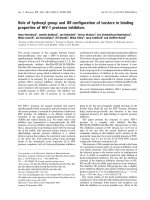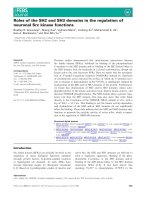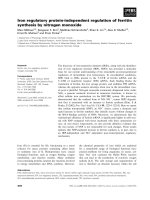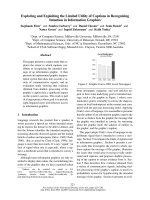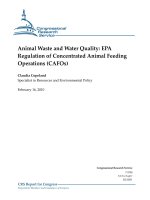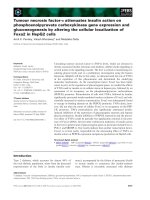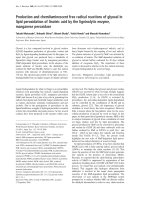Cyclic nucleotides and mitogen-activated protein kinases: regulation of simvastatin in platelet activation pptx
Bạn đang xem bản rút gọn của tài liệu. Xem và tải ngay bản đầy đủ của tài liệu tại đây (1 MB, 10 trang )
Lee et al. Journal of Biomedical Science 2010, 17:45
/>Open Access
RESEARCH
© 2010 Lee et al; licensee BioMed Central Ltd. This is an Open Access article distributed under the terms of the Creative Commons At-
tribution License ( which permits unrestricted use, distribution, and reproduction in any
medium, provided the original work is properly cited.
Research
Cyclic nucleotides and mitogen-activated protein
kinases: regulation of simvastatin in platelet
activation
Ye-Ming Lee
†1,2
, Wei-Fan Chen
†3
, Duen-Suey Chou
2
, Thanasekaran Jayakumar
3
, Ssu-Yu Hou
3
, Jie-Jen Lee
2
,
George Hsiao
2
and Joen-Rong Sheu*
2,3
Abstract
Background: 3-Hydroxy-3-methyl-glutaryl coenzyme A (HMG-CoA) reductase inhibitors (statins) have been widely
used to reduce cardiovascular risk. These statins (i.e., simvastatin) may exert other effects besides from their cholesterol-
lowering actions, including inhibition of platelet activation. Platelet activation is relevant to a variety of coronary heart
diseases. Although the inhibitory effect of simvastatin in platelet activation has been studied; the detailed signal
transductions by which simvastatin inhibit platelet activation has not yet been completely resolved.
Methods: The aim of this study was to systematically examine the detailed mechanisms of simvastatin in preventing
platelet activation. Platelet aggregation, flow cytometric analysis, immunoblotting, and electron spin resonance studies
were used to assess the antiplatelet activity of simvastatin.
Results: Simvastatin (20-50 μM) exhibited more-potent activity of inhibiting platelet aggregation stimulated by
collagen than other agonists (i.e., thrombin). Simvastatin inhibited collagen-stimulated platelet activation
accompanied by [Ca
2+
]i mobilization, thromboxane A
2
(TxA
2
) formation, and phospholipase C (PLC)γ2, protein kinase C
(PKC), and mitogen-activated protein kinases (i.e., p38 MAPK, JNKs) phosphorylation in washed platelets. Simvastatin
obviously increased both cyclic AMP and cyclic GMP levels. Simvastatin markedly increased NO release, vasodilator-
stimulated phosphoprotein (VASP) phosphorylation, and endothelial nitric oxide synthase (eNOS) expression.
SQ22536, an inhibitor of adenylate cyclase, markedly reversed the simvastatin-mediated inhibitory effects on platelet
aggregation, PLCγ2 and p38 MAPK phosphorylation, and simvastatin-mediated stimulatory effects on VASP and eNOS
phosphorylation.
Conclusion: The most important findings of this study demonstrate for the first time that inhibitory effect of
simvastatin in platelet activation may involve activation of the cyclic AMP-eNOS/NO-cyclic GMP pathway, resulting in
inhibition of the PLCγ2-PKC-p38 MAPK-TxA
2
cascade, and finally inhibition of platelet aggregation.
Background
A high incidence of atherosclerosis and thrombotic com-
plications has been associated with hypercholester-
olemia. Blood cholesterol levels are of fundamental
importance in the pathogenesis of coronary artery dis-
eases (CAD). Elevations of low-density lipoprotein (LDL)
levels are not only linked to an increased risk for athero-
sclerosis but may also exert prothrombotic effects via
platelet activation [1]. The effectiveness of 3-hydroxy-3-
methyl-glutaryl coenzyme A (HMG-CoA) reductase
inhibitors (statins) in the prevention of CAD is ascribed
not only to reduced cholesterol levels [2,3], but also to a
number of additional effects, including the stabilization
of atherosclerotic plaque, improved endothelial function,
enhanced fibrinolysis, and antithrombotic effects [3-5].
Although many studies have demonstrated that statins
have antiplatelet activity in hypercholesterolemic patients
and animals [6], the inhibition of platelet-dependent
thrombus formation in hypercholesterolemia may not
correlate with the lipid-lowering effects, suggesting that
* Correspondence:
2
Department of Pharmacology, Taipei Medical University, Taipei, Taiwan
†
Contributed equally
Full list of author information is available at the end of the article
Lee et al. Journal of Biomedical Science 2010, 17:45
/>Page 2 of 10
these statins may exert another effect besides from their
cholesterol-lowering actions.
Inhibition of the thromboxane B
2
formation or chang-
ing cholesterol content on platelet membrane by statins
has been reported [7,8]. Recently, Chou et al. [6] also sug-
gested that enhanced nitric oxide (NO) and cyclic GMP
formation of simvastatin (20-80 μM) may be involved in
the inhibitory effects on platelet aggregation. The anti-
platelet activity of simvastatin in platelets has been stud-
ied; however, the detailed signal transduction mechanism
by which simvastatin inhibits platelet activation has not
yet been completely resolved. We therefore systematically
examined the cellular signal events associated with sim-
vastatin-inhibited platelet activation in the present study.
Methods
Materials
Collagen (type I), luciferin-luciferase, phorbol-12, 13-
dibutyrate (PDBu), 5,5-dimethyl-1 pyrroline N-oxide
(DMPO), SQ22536, ODQ, arachidonic acid (AA), prosta-
glandin E
1
(PGE
1
), nitroglycerin, and thrombin were pur-
chased from Sigma Chem. (St Louis, MO); Fura 2-AM
and fluorescein iso-thiocyanate (FITC) were from Molec-
ular Probe (Eugene, OR); the thromboxane B
2
enzyme
immunoassay (EIA) kit was from Cayman (Ann Arbor,
MI); the anti-vasodilator-stimulated phosphoprotein
(VASP Ser
157
) monoclonal antibody (mAb) was from Cal-
biochem (San Diego, CA); the anti-phospho-p38 mito-
gen-activated protein kinase (MAPK) Ser
182
mAb was
from Santa Cruz (Santa Cruz, CA); the anti-p38 MAPK
and anti-phospho-c-Jun N-terminal kinase (JNK)
(Thr
183
/Tyr
185
) mAbs, anti-phospholipase Cγ2 (PLCγ2),
anti-phospho (Tyr
759
) PLCγ2 mAbs, and the anti-phos-
pho-p44/p42 extracellular signal-regulated kinase (ERK)
(Thr
202
/Tyr
204
) polyclonal antibody (pAb) were from Cell
Signaling (Beverly, MA); the anti-α-tubulin mAb was
from NeoMarkers (Fremont, CA); and the Hybond-P
PVDF membrane, ECL Western blotting detection
reagent and analysis system, horseradish peroxidase
(HRP)-conjugated donkey anti-rabbit IgG, and sheep
anti-mouse IgG were from Amersham (Buckinghamshire,
UK). Cyclic AMP and cyclic GMP EIA kits were pur-
chased from Cayman (Ann Arbor, MI). Simvastatin was
dissolved in 0.5% dimethyl sulfoxide (DMSO) and stored
at 4°C until used.
Platelet aggregation
Human platelet suspensions were prepared as previously
described [9]. This study was approved by the Institu-
tional Review Board of Taipei Medical University and
conformed to the principles outlined in the Helsinki Dec-
laration, and all human volunteers provided informed
consent. In brief, blood was collected from healthy
human volunteers who had taken no medicine during the
preceding 2 weeks, and was mixed with acid/citrate/glu-
cose (9:1:1, v/v). After centrifugation, the supernatant
(platelet-rich plasma; PRP) was supplemented with pros-
taglandin E
1
(PGE
1
) (0.5 μM) and heparin (6.4 IU/ml).
The washed platelets were finally suspended in Tyrode's
solution containing bovine serum albumin (BSA) (3.5
mg/ml). The final concentration of Ca
2+
in Tyrode's solu-
tion was 1 mM.
A turbidimetric method was applied to measure plate-
let aggregation [9], using a Lumi-Aggregometer (Payton,
Scarborough, Ontario, Canada). Platelet suspensions (0.4
ml) were preincubated with various concentrations of
simvastatin or an isovolumetric solvent control (0.5%
DMSO) for 3 min before the addition of agonists. The
reaction was allowed to proceed for 6 min, and the extent
of aggregation was expressed in light-transmission units.
When measuring ATP release, 20 μl of a luciferin/
luciferase mixture was added 1 min before the addition of
agonists, and ATP release was compared to that of the
control.
Measurement of cyclic AMP and cyclic GMP formations
Platelet suspensions (3.6 × 10
8
/ml) were incubated with
isovolumetric solvent control (0.5% DMSO), nitroglyc-
erin (10 μM), PGE
1
(10 μM), or simvastatin (30 and 50
μM) for 6 min. The incubation was stopped by the addi-
tion of EDTA (5 mM), and the solution was immediately
boiled for 5 min. Fifty microliters of the supernatant was
used to determine the cyclic AMP and cyclic GMP con-
tents with EIA kits following acetylation of the samples as
described by the manufacturer.
Flow cytometric analysis
Triflavin, an α
IIb
β
3
integrin antagonist, was prepared as
previously described [10]. Fluorescence-conjugated tri-
flavin was prepared as previously described [10]. Platelet
suspensions (3.6 × 10
8
/ml) were preincubated with sim-
vastatin (30 and 50 μM) or a solvent control for 3 min,
followed by the addition of 2 μl of FITC-triflavin (2 μg/
ml). The suspensions were then assayed for fluorescein-
labeled platelets using a flow cytometer (Beckman
Coulter, Miami, FL). Data were collected from 50,000
platelets per experimental group, and the platelets were
identified on the basis of their characteristic forward and
orthogonal light-scattering profile. All experiments were
repeated at least four times to ensure reproducibility.
Measurement of platelet [Ca
2+
]i by Fura 2-AM fluorescence
Citrated whole blood was centrifuged at 120 g for 10 min.
The supernatant was incubated with Fura 2-AM (5 μM)
for 1 h. Human platelets were then prepared as described
above. Finally, the external Ca
2+
concentration of the
platelet suspensions was adjusted to 1 mM. The [Ca
2+
]i
Lee et al. Journal of Biomedical Science 2010, 17:45
/>Page 3 of 10
rise was measured using a fluorescence spectrophotome-
ter (CAF 110, Jasco, Tokyo, Japan) with excitation wave-
lengths of 340 and 380 nm, and an emission wavelength
of 500 nm [9].
Measurement of thromboxane B
2
formation
Platelet suspensions (3.6 × 10
8
/ml) were preincubated
with simvastatin (30 and 50 μM) or solvent control for 3
min before the addition of collagen (1 μg/ml). Six minutes
after the addition of agonists, 2 mM EDTA and 50 μM
indomethacin were added to the suspensions. The
thromboxane B
2
(TxB
2
) levels of the supernatants were
measured using an EIA kit.
Immunoblotting study
Washed platelets (1.2 × 10
9
/ml) were preincubated with
simvastatin (30 and 50 μM) or a solvent control for 3 min,
followed by the addition of agonists to trigger platelet
activation. The reaction was stopped, and platelets were
immediately re-suspended in 200 μl of lysis buffer. Sam-
ples containing 80 μg of protein were separated by SDS-
PAGE (12%); the proteins were electrotransferred by
semidry transfer (Bio-Rad, Hercules, CA). Blots were
blocked with TBST (10 mM Tris-base, 100 mM NaCl,
and 0.01% Tween 20) containing 5% BSA for 1 h and then
probed with various primary antibodies. Membranes
were incubated with HRP-linked anti-mouse IgG or anti-
rabbit IgG (diluted 1: 3000 in TBST) for 1 h. Immunore-
active bands were detected by an enhanced chemilumi-
nescence (ECL) system. The bar graph depicts the ratios
of quantitative results obtained by scanning reactive
bands and quantifying the optical density using vid-
eodensitometry (Bio-profil; Biolight Windows Applica-
tion V2000.01; Vilber Lourmat, France).
Estimation of nitrate formation
NO was assayed in platelet suspensions as previously
described [10]. In brief, platelet suspensions (1.2 × 10
9
/
ml) were preincubated with PGE
1
(10 μM) or simvastatin
(30 and 50 μM) for 3 min, followed by centrifugation. The
amount of nitrate in the platelet suspensions (10 μl) was
measured by adding a reducing agent to the purge vessel
to convert nitrate to NO which was stripped from the
suspensions by purging with helium gas. The NO was
then drawn into a Sievers Nitric Oxide Analyzer (Sievers
280 NOA, Sievers, Boulder, CO). Nitrate concentrations
were calculated by comparison with standard solutions of
sodium nitrate.
Measurement of hydroxyl radical by electron spin
resonance (ESR) spectrometry
The ESR method used a Bruker EMX ESR spectrometer
as described previously [11]. In brief, platelet suspensions
(3.6 × 10
8
/ml) were preincubated with simvastatin (30
and 50 μM) or solvent control for 3 min before the addi-
tion of collagen (1 μg/ml). The reaction was allowed to
proceed for 5 min, followed by the addition of DMPO
(100 μM) for the ESR study. The rate of hydroxyl radical-
scavenging activity is defined by the following equation:
inhibition rate = 1-[signal height (simvastatin)/signal
height (solvent control)] [11].
Statistical analysis
The experimental results are expressed as the means ±
S.E.M. and are accompanied by the number of observa-
tions. The experiments were assessed by the method of
analysis of variance (ANOVA). If this analysis indicated
significant differences among group means, then each
group was compared using the Newman-Keuls method. P
< 0.05 was considered statistically significant.
Results
Effects of simvastatin on platelet aggregation, α
IIb
β
3
integrin conformational change, and [Ca
2+
]i mobilization in
human platelets
Simvastatin (20-70 μM) exhibited potent activity of
inhibiting platelet aggregation and the ATP-release reac-
tion stimulated by collagen (1 μg/ml, open circle). It also
significantly inhibited platelet aggregation stimulated by
thrombin (0.02 U/ml, open square), AA (60 μM, open
diamond) or U46619 (1 μM, open triangle), a prostaglan-
din endoperoxide at higher concentrations (70-100 μM)
(Fig. 1A and 1B). The IC
50
value of simvastatin for platelet
aggregation induced by collagen was approximately 30
μM. The solvent control (0.5% DMSO) did not signifi-
cantly affect platelet aggregation stimulated by agonists
in washed platelets (Fig. 1A). When platelets were prein-
cubated with a higher concentration of simvastatin (200
μM) or 0.5% DMSO for 10 min, followed by two washes
with Tyrode's solution, there were no significant differ-
ences between the aggregation curves of either platelet
preparations stimulated by collagen (1 μg/ml), indicating
that the effect of simvastatin on inhibition of platelet
aggregation occurs in a reversible manner (data not
shown). In subsequent experiments, we used collagen as
an agonist to explore the inhibitory mechanisms of sim-
vastatin in platelet activation.
Triflavin is an Arg-Gly-Asp-containing antiplatelet
peptide purified from Trimeresurus flavoviridis snake
venom [10]. Triflavin inhibits platelet aggregation
through direct interference with fibrinogen binding to
the α
IIb
β
3
integrin [10]. There is now a multitude of evi-
dence suggesting that the binding of fibrinogen to the
α
IIb
β
3
integrin is the final common pathway for agonist-
induced platelet aggregation. Therefore, we further eval-
uated whether or not simvastatin directly binds to the
platelet α
IIb
β
3
integrin, leading to interruption of platelet
Lee et al. Journal of Biomedical Science 2010, 17:45
/>Page 4 of 10
Figure 1 Effects of simvastatin on the inhibition of (A and B) platelet aggregation, (C) FITC-triflavin binding to the α
IIb
β
3
integrin and (D)
[Ca
2+
]i mobilization in activated platelets. Washed platelets (3.6 × 10
8
/ml) were preincubated with simvastatin (10-100 μM) or 0.5% DMSO, fol-
lowed by the addition of collagen (1 μg/ml, open circle), U46619 (1 μM, upside down open triangle), thrombin (0.02 U/ml, open square) or arachidonic
acid (60 μM, open diamond) to trigger platelet aggregation (A and B) and the ATP-release reaction (A, upper tracings) or (D) [Ca
2+
]i mobilization. (C)
The solid line represents the fluorescence profiles of FITC-triflavin (2 μg/ml) (a) with or (b) without EDTA (5 mM); or pretreatment of simvastatin (c) (30
μM) and (d) (50 μM), followed by the addition of FITC-triflavin (2 μg/ml). Data are presented as the means ± S.E.M. (n = 4); ***P < 0.001, compared to
the control group;
#
P < 0.05 and
##
P < 0.01, compared to the collagen group.
[Ca
2+
]
i (nM)
0
20
40
60
80
100
120
140
160
180
200
Fluorescence intensity (folds)
0
1
2
3
4
5
0 20 40 60 80 100 120
0
20
40
60
80
100
ʳ
A
B
C
DMSO
Ц
Х
collagen
simvastatin
30
Ц
Х
50
Ц
Х
ATP release
ǻT(10%)
min
a
b
c
d
D
**
***
***
collagen
+ + +
simvastatin
30 50
***
#
##
0
0 0
0
85
85
85
85
10
0
10
1
10
2
10
3
10
0
10
1
10
2
10
3
10
0
10
1
10
2
10
3
10
0
10
1
10
2
10
3
Fluorescence intensity
Number of cells
a
d
c
b
Concentration (
P
M)
Inhibition (%)
Lee et al. Journal of Biomedical Science 2010, 17:45
/>Page 5 of 10
aggregation induced by collagen. In this study, the relative
intensity of the fluorescence of FITC-triflavin (2 μg/ml)
bound directly to collagen (1 μg/ml)-activated platelets
was relatively higher than that of negative control (in the
presence of 5 mM EDTA) (a, 1.4 ± 0.2; b, 4.8 ± 0.4) (Fig.
1C). Simvastatin (30 and 50 μM) did not significantly
affect FITC-triflavin binding to the α
IIb
β
3
integrin in
platelet suspensions (c, 4.8 ± 0.1; d, 4.9 ± 0.1) (Fig. 1C),
indicating that the inhibitory effect of simvastatin on
platelet aggregation does not involve binding to the plate-
let α
IIb
β
3
integrin.
Free cytoplasmic Ca
+2
concentrations in human plate-
lets were measured by the Fura 2-AM loading method. As
shown in Figure 1D, collagen (1 μg/ml) evoked a marked
increase in [Ca
2+
]i, and this increase was markedly inhib-
ited in the presence of simvastatin (30 μM, 60.9 ± 17.0%;
50 μM, 72.1 ± 7.9%).
Effects of simvastatin on TxA
2
, PLCγ2, and PKC activation
As shown in Figure 2A, resting platelets produced rela-
tively little TxB
2
compared to collagen-activated platelets.
Simvastatin (30 and 50 μM) concentration-dependently
inhibited TxB
2
formation in platelets stimulated by colla-
gen (1 μg/ml). PLC hydrolyzes phosphatidylinositol 4,5-
bisphosphate (PIP
2
) to generate two secondary messen-
gers: inositol 1,4,5-trisphosphate (IP
3
) and diacylglycerol
(DAG) [12]. DAG activates PKC, inducing protein phos-
phorylation (p47) and ATP release. Phosphorylation is
one of the key mechanisms regulating the activity of PLC.
The immunoblotting analysis revealed that treatment
with simvastatin markedly abolished the phosphorylation
of PLCγ2 stimulated by collagen (Fig. 2B). Stimulation of
platelets with a number of different agonists induced acti-
vation of PKC, which then phosphorylated p47 proteins.
In this study, phosphorylation experiments were per-
formed to examine the role of simvastatin in PKC activa-
tion in human platelets. When collagen (1 μg/ml) (Fig.
2C) or PDBu (150 nM) (Fig. 2D) was added to human
platelets, a protein with an apparent of p47 was predomi-
nately phosphorylated compared to resting platelets.
Simvastatin inhibited p47 phosphorylation stimulated by
collagen but not by PDBu (Fig. 2C and 2D).
Effect of simvastatin on collagen-induced MAPK
phosphorylation
To further investigate the inhibitory mechanisms of sim-
vastatin in platelet activation stimulated by collagen, we
further detected MAPK signaling molecules including
p38 MAPK, JNKs, and ERKs. The immunoblotting analy-
sis revealed that simvastatin (50 μM) inhibited p38
MAPK (Fig. 3A) and JNKs (Fig. 3B), but not ERKs (Fig.
3C) phosphorylation stimulated by collagen. In addition,
in the presence of SQ22536 (100 μM), an inhibitor of ade-
nylate cyclase, significantly reversed the simvastatin-
mediated inhibition of p38 MAPK phosphorylation stim-
ulated by collagen (Fig. 3D).
Effects of simvastatin on cyclic nucleotides, nitrate
formation and VASP phosphorylation
The level of cyclic AMP in unstimulated platelets was
less, the addition of PGE
1
(10 μM) markedly increased
approximately 4.3-fold of cyclic AMP level compared
with the resting group (Fig. 4A). Simvastatin (30 and 50
μM) significantly increased the cyclic AMP levels in
human platelets (30 μM, 5.3 ± 1.2 nM; 50 μM, 6.3 ± 1.6
nM; n = 3) (Fig. 4A). We also performed a similar study
measuring the cyclic GMP response. The level of cyclic
GMP in unstimulated platelets was about 1.5 ± 0.3 nM,
but when nitroglycerin (NTG, 10 μM) was added to the
platelet suspensions, the cyclic GMP level markedly
increased from the resting level to 4.0 ± 0.6 nM (n = 3)
(Fig. 4A). The addition of simvastatin (30 and 50 μM)
Figure 2 Effects of simvastatin on (A) thromboxane B
2
formation,
(B) phospholipase Cγ2 and (C and D) PKC substrate (p47) phos-
phorylation in activated platelets. Washed platelets were preincu-
bated with simvastatin (30 and 50 μM) or 0.5% DMSO, followed by the
addition of collagen (1 μg/ml) or PDBu (150 nM) to trigger platelet ac-
tivation. Cells were collected, and subcellular extracts were analyzed
for (A) thromboxane A
2
formation, (B) phospholipase Cγ2 phosphory-
lation, and (C and D) phospho-PKC substrate (p-p47) as described in
"Methods". Data are presented as the means ± S.E.M. (n = 4); *P < 0.05
and **P < 0.01, compared to the control group;
#
P < 0.05 and
##
P < 0.01,
compared to the collagen group.
0
1
2
3
4
5
0
1
2
3
4
0
10
20
30
40
50
0
1
2
3
4
5
6
7
8
A
B
collagen
+ + +
simvastatin
30 50
collagen
ʳ
+ + +
simvastatin
30 50
PDBu
+ + +
simvastatin
30 50
C
D
**
#
*
p
-PLC
J
2
PLC
J
2
#
p-p47
p-p47
D
-tubulin
D
-tubulin
**
**
#
##
PLC
J
2 phosphorylation
(folds/basal)
Thromboxane B
2
(ng/ml)
p47 phosphorylation
(folds/basal)
p47 phosphorylation
(folds/basal)
collagen
ʳ
+ + +
simvastatin
30 50
Lee et al. Journal of Biomedical Science 2010, 17:45
/>Page 6 of 10
resulted in significant increases in platelet cyclic GMP
levels (30 μM, 2.6 ± 0.3 nM; 50 μM, 2.9 ± 0.4 nM; n = 3)
(Fig. 4A). NO was quantified using a sensitive and spe-
cific ozone redox-chemiluminescence detector. As shown
in Figure 4B, simvastatin (30 and 50 μM) concentration-
dependently increased nitrate production after incuba-
tion with washed platelets (Fig. 4B). It was demonstrated
that cyclic nucleotides can induce VASP Ser
157
phospho-
rylation in human platelets [13]. In this study, PGE
1
(10
μM) and simvastatin (30 and 50 μM) markedly induced
VASP Ser
157
phosphorylation (Fig. 4C). SQ22536 (100
μM) significantly inhibited the phosphorylation stimu-
lated by both PGE
1
(10 μM) and simvastatin (50 μM) (Fig.
4C). Furthermore, SQ22536 (100 μM) obviously reversed
the simvastatin (50 μM)-mediated inhibitory effect of
PLCγ2 phosphorylation stimulated by collagen (Fig. 4D).
On the other hand, pretreatment with SQ22536 (100 μM)
or ODQ (20 μM), an inhibitor of guanylate cyclase, signif-
icantly reversed the simvastatin (50 μM)-mediated inhi-
bition of platelet aggregation stimulated by collagen (Fig.
4E and 4F). These results indicate that simvastatin inhib-
its platelet aggregation, al least in part, via a cyclic nucle-
otides-dependent pathway.
Effects of simvastatin on eNOS phosphorylation and
hydroxyl radical formation
Endothelial nitric oxide synthase (eNOS) phosphoryla-
tion was markedly activated by both PGE
1
(10 μM) and
simvastatin (50 μM) (Fig. 5A). The simvastatin-activated
eNOS phosphorylation was significantly reversed in the
presence of SQ22536 (100 μM) but not by ODQ (20 μM),
indicating that cyclic AMP plays an up-regulator in sim-
vastatin-mediated eNOS phosphorylation in human
platelets (Fig. 5A). On the other hand, a typical ESR signal
of hydroxyl radical (OH
•
) formation was induced in colla-
gen (1 μg/ml)-activated platelets compared to resting
platelets (Fig. 5B, a and 5b); pretreatment with simvasta-
tin (30 and 50 μM) did not significantly reduce hydroxyl
radical formation stimulated by collagen (Fig. 5B, c and
5d). The antioxidant, catalase (1000 U/ml), markedly sup-
pressed hydroxyl radical formation by about 78% (data
not shown).
Discussion
This study demonstrates for the first time that simvasta-
tin inhibits platelet activation via a novel pathway: activa-
tion of cyclic AMP-eNOS/NO-cyclic GMP and inhibition
of MAPK phosphorylation (i.e., p38 MAPK and JNKs) in
washed platelets. Simvastatin exhibited more-potent
activity at inhibiting collagen-induced platelet aggrega-
tion than other agonists. For the clinical therapy, the
approved starting dose of simvastatin for most patients is
20 mg, and the maximal dose is 80 mg. In this study, the
concentrations of simvastatin were employed at 30 and
50 μM, and the concentration of collagen was used at 1
μg/ml to trigger platelet aggregation. In general, concen-
trations of collagen were employed for platelet aggrega-
tion of from 0.1 to 5 μg/ml. In an attempt to elucidate the
detailed mechanisms of pharmacological interest, we
used a higher concentration (1 μg/ml) of collagen to
induce a more-pronounced signal transduction in plate-
lets (i.e., MAPKs and PKC etc.). Therefore, the pharma-
cological concentrations (30-50 μM) of simvastatin
employed to inhibit platelet aggregation in vitro are rea-
sonable higher than that of blood concentrations
obtained during a simvastatin regimen in vivo. However,
the concentration employed is closely to that of other in
vitro studies (20-80 μM) [6,14,15].
Stimulation of platelets by agonists (i.e., collagen)
causes marked alterations in phospholipid metabolism.
The activation of PLC results in the degradation of phos-
phoinositides, notably, phosphatidylinositol 4,5-bisphos-
phate (PI4,5-P
2
), resulting in the production of the
second messengers, inositol 1,4,5-trisphosphate (IP
3
) and
Figure 3 Effects of simvastatin on (A and D) p38 MAPK, (B) JNKs,
and (C) ERKs phosphorylation in activated platelets. Washed plate-
lets (1.2 × 10
9
/ml) were preincubated with simvastatin (30 and 50 μM)
or 0.5% DMSO, followed by the addition of collagen (1 μg/ml) to trig-
ger (A and D) p38 MAPK, (B) JNKs, and (C) ERKs phosphorylation. Data
are presented as the means ± S.E.M. (n = 4); *P < 0.05 and **P < 0.01,
compared to the control group;
#
P < 0.05, compared to the collagen
group.
0.0
0.5
1.0
1.5
2.0
2.5
0.0
0.5
1.0
1.5
2.0
2.5
3.0
0
1
2
3
4
0.0
0.5
1.0
1.5
2.0
collagen
ʳ
+ + +
simvastatin
30 50
collagen
+ + +
simvastatin
30 50
JNK1/2
p-JNK1/2
p-p38 MAPK
total-p38 MAPK
**
#
*
A
B
C
p38 MAPK phosphorylation
(folds/basal)
JNK1/2 phosphorylation
(folds/basal)
collagen
ʳ
+ + +
simvastatin
30 50
p-ERK1/2
ERK1/2
ERK1/2 phosphorylation
(folds/basal)
*
#
p-p38 MAPK
total-p38 MAPK
D
collagen
+++
simvastatin
50 50
SQ 22536
+
p38 MAPK phosphorylation
(folds/basal)
***
###
P
0.05
Lee et al. Journal of Biomedical Science 2010, 17:45
/>Page 7 of 10
Figure 4 Effects of simvastatin on (A) cyclic nucleotides (B) nitrate formations, (C) Ser
157
-vasodilator-stimulated phosphoprotein (VASP)
and (D) phospholipase Cγ2 phosphorylation as well as (E and F) platelet aggregation in the presence of inhibitors of cyclic nucleotides in
washed platelets. Platelets were incubated with prostaglandin E
1
(PGE
1
, 10 μM), nitroglycerin (NTG, 10 μM), simvastatin (30 and 50 μM), or 0.5% DM-
SO. Cells were collected, and subcellular extracts were analyzed for (A) cyclic nucleotides, (B) nitrate formations (C) Ser
157
-VASP, and (D) phospholipase
Cγ2 phosphorylations as described in "Methods". For platelet aggregation study, washed platelets were preincubated with simvastatin (50 μM) in the
absence or presence of (E) ODQ (20 μM) or (F) SQ22536 (100 μM), followed by the addition of collagen (1 μg/ml). Data are presented as the means ±
S.E.M. (n = 3-4); *P < 0.05, **P < 0.01, and ***P < 0.001, compared to the control group;
#
P < 0.05, compared to the without SQ22536 groups.
≠
P < 0.05,
compared to the collagen plus simvastatin group. The profiles (E and F) are representative examples of four similar experiments.
0.0
0.5
1.0
1.5
2.0
2.5
3.0
0.0
0.5
1.0
1.5
2.0
0
2
4
6
8
10
12
14
0
1
2
3
4
5
0
1
2
3
4
5
pSer
157
-VASP
D
-tubulin
**
**
***
*
*
#
B
DMSO
Ц
Х
collagen
simvastatin
50
Ц
Х
Х
simvastatin
50
Ц
Х
ODQ
DMSO
Ц
Х
collagen
simvastatin
50
Ц
Х
simvastatin
50
Ц
Х
SQ22536
Х
min
ǻT(10%)
C
D
Nitrate (
P
M)
VASP phosphorylation
(folds/basal)
DMSO
30
50
simvastatin
P
0.05
#
P
0.05
PGE
1
+
+
simvastatin
30 50
50
SQ 22536
+ +
Cyclic AMP (nM)
Cyclic GMP (nM)
collagen
+ + +
simvastatin
50 50
SQ 22536
+
p-PLC
J
2
PLC
J
2
PLC
J
2 phosphorylation
(folds/basal)
*
#
Ћ
A
E
F
***
*
*
**
*
*
R PGE
1
30 50
simvastatin
NTG R 30 50
simvastatin
Lee et al. Journal of Biomedical Science 2010, 17:45
/>Page 8 of 10
DAG [16]. DAG activates PKC, inducing protein phos-
phorylation (p47). PKC activation represents a strategy
adopted by cells to allow selected responses to specific
activating signals in distinct cellular compartments [17].
Phosphoinositide-specific PLC is a key enzyme in signal
transduction [18]. There are six major families of PLC
enzymes which consist of at least 13 PLC isoforms [18].
PLCγ2 is involved in antigen-dependent signaling in B
cells and collagen-dependent signaling in platelets [19].
In this study, both PLCγ2 phosphorylation and PKC acti-
vation stimulated by collagen were inhibited by simvasta-
tin, suggesting that simvastatin-mediated antiplatelet
activity is involved in inhibition of the PLCγ2-PKC signal
pathway. Simvastatin had no direct effect on PKC activa-
tion, as it did not inhibit PDBu-induced PKC activation
(Fig. 2D) or platelet aggregation (data not shown). In
addition, collagen-induced TxB
2
formation, a stable
metabolite of TxA
2
, was markedly inhibited by simvasta-
tin. TxA
2
is important for collagen-induced platelet
aggregation. This may explain the more-potent activity of
simvastatin in inhibiting collagen-induced platelet aggre-
gation than other agonists (thrombin and U46619).
MAPKs consist of three major subgroups. Growth fac-
tors preferentially activate ERKs (p44 ERK1 and p42
ERK2), which are involved in proliferation, adhesion, and
cell progression [20], whereas p38 MAPK and JNKs (p46
JNK1 and p54 JNK2) are more responsive to stress, and
appear to be involved in apoptosis [20]. ERKs, JNKs, and
p38 MAPK have been identified in platelets [20]. The
roles of JNKs and ERKs in physiopathology are unclear,
but they have been suggested to be suppressors of α
IIb
β
3
integrin activation or negative regulators of platelet acti-
vation [21]. On the other hand, p38 MAPK provides a
crucial signal as a downstream effector of PKC which is
necessary for aggregation caused by collagen [22].
Among the numerous downstream targets of p38 MAPK,
the most physiologically relevant one in platelets is cyto-
solic phospholipase A
2
(cPLA
2
). p38 MAPK is essential
for the stimulation of cPLA
2
, which catalyzes AA release
to produce TxA
2
[23]; thus, p38 MAPK appears to pro-
vide a TxA
2
-dependent platelet aggregation pathway.
Simvastatin significantly inhibits TxA
2
formation, at least
in part, via inhibition of p38 MAPK phosphorylation.
Activation of human platelets is inhibited by two intra-
cellular pathways regulated by either cyclic AMP or cyclic
GMP. The importance of cyclic AMP and cyclic GMP in
modulating platelet reactivity is well established [24]. In
addition to inhibiting most platelet responses, elevated
levels of cyclic AMP or/and cyclic GMP decrease intrac-
ellular Ca
2+
concentrations by the uptake of Ca
2+
into the
dense tubular system (DTS) which negatively affects the
Figure 5 Effects of simvastatin on (A) endothelial nitric oxide syn-
thase (eNOS) phosphorylation and (B) hydroxyl radical (OH
•
) for-
mation in activated platelets. (A) Platelets were incubated with
prostaglandin E
1
(PGE
1
, 10 μM), simvastatin (30 and 50 μM), or 0.5%
DMSO in the absence or presence of SQ22536 (100 μM) or ODQ (20
μM) as described in "Methods". Cells were collected, and subcellular
extracts were analyzed for eNOS phosphorylation. Data are presented
as the means ± S.E.M. (n = 4); **P < 0.01 and ***P < 0.001, compared to
the control group;
#
P < 0.05, compared to the PGE
1
group. (B) For the
electron spin resonance (ESR) study, platelets were preincubated with
(a) Tyrode's solution (resting group), (b) a solvent control (0.5% DMSO),
or simvastatin (30 and 50 μM), followed by the addition of collagen (1
μg/ml) to trigger platelet activation. Spectra are representative exam-
ples of four similar experiments. Asterisk (*) indicates the formation of
hydroxyl radical.
0.0
0.5
1.0
1.5
2.0
2.5
3.0
3.5
A
PGE
1
+
simvastatin
50 50 50
ODQ
+
SQ 22536
+
eNOS phosphorylation
(folds/basal)
p-eNOS
eNOS
***
**
B
P
0.05
#
*
*
*
*
*
*
*
*
*
Lee et al. Journal of Biomedical Science 2010, 17:45
/>Page 9 of 10
action of PLC and/or PKC [24]. Therefore, cyclic AMP
and cyclic GMP act synergistically to inhibit platelet
aggregation. In this study, simvastatin obviously
increased the levels of both cyclic AMP and cyclic GMP
in human platelets. Platelets produce NO in smaller
amounts than do endothelial cells [25]. Most cellular
actions of NO occur via stimulation of intracellular gua-
nylate cyclase, leading to increases in cyclic GMP. Both
the inducible NOS (iNOS) and eNOS isoforms have been
described in platelets, but eNOS is predominant [25].
Simvastatin (80 μM) has been reported to induce NO
release and stimulate eNOS activity in rabbit platelets [6].
In this study, SQ22536 markedly reversed simvastatin-
mediated inhibition of platelet aggregation, PLCγ2, and
p38 MAPK phosphorylation stimulated by collagen, and
it also reversed the simvastatin-mediated activation of
both eNOS and VASP phosphorylations. VASP is phos-
phorylated by cyclic nucleotide-dependent protein kinase
in platelets, which plays important role in modulating
actin filament dynamics and integrin activation [13]. In
this study, simvastatin was found to stimulate eNOS
phosphorylation, and this effect was reversed by
SQ22536 but not by ODQ. This result is in accord with
that of increased cyclic AMP stimulating eNOS activity
and NO biosynthesis [26].
Reactive oxygen species (i.e., hydrogen peroxide and
hydroxyl radicals) derived from platelet activation might
amplify platelet reactivity during thrombus formation.
Free radical species act as secondary messengers that
increase cytosolic Ca
2+
during the initial phase of platelet
activation processes, and PKC is involved in receptor-
mediated free radical production in platelets [11]. The
antiplatelet effect of simvastatin did not mediate by the
free radical-scavenging activity in ESR experiment.
In conclusion, the most important findings of this study
demonstrate for the first time that the antiplatelet activity
of simvastatin may involve an increase of the cyclic AMP-
eNOS/NO-cyclic GMP pathway, followed by inhibition
of the PLCγ2-PKC-p38 MAPK-TxA
2
cascade, thereby
leading to inhibition of platelet aggregation. Hypercho-
lesterolemic patients usually associate with a high inci-
dence of atherosclerosis and thrombotic complications.
This study provides a new insight of antiplatelet mecha-
nisms of simvastatin to explain its clinical protective
effect in CAD.
Competing interests
The authors declare that they have no competing interests.
Authors' contributions
YML and WFC carried out the platelet aggregation study and drafted the man-
uscript. DSC carried out the ESR study. TJ, SYH, and JJL carried out the immuno-
blotting study. GH performed the statistical analysis. JRS conceived of the
study, and participated in the design and coordination, and collectively pre-
pared the manuscript. All authors read and approved the final manuscript.
Acknowledgements
This work was supported by grants from the National Science Council of Tai-
wan (NSC97-2320-B-038-016-MY3) and Hsinchu Mackay Memorial Hospital
(MMH-HB-96-02; MMH-HB-97-01).
Author Details
1
Department of Surgery, Hsinchu Mackay Memorial Hospital, Hsinchu; Mackay
Medicine, Nursing and Management College, Taipei, Taiwan,
2
Department of
Pharmacology, Taipei Medical University, Taipei, Taiwan and
3
Graduate
Institute of Medical Sciences, Taipei Medical University, Taipei, Taiwan
References
1. Notarbartolo A, Davi G, Averna M, Barbagallo CM, Ganci A, Giammarresi C,
La Placa FP, Patrono C: Inhibition of thromboxane biosynthesis and
platelet function by simvastatin in type IIa hypercholesterolemia.
Arterioscler Thromb Vasc Biol 1995, 15:247-251.
2. Maron DJ, Fazio S, Linton MF: Current perspectives on statins. Circulation
2000, 101:207-213.
3. Undas A, Brummel KE, Musial J, Mann KG, Szczeklik A: Simvastatin
depresses blood clotting by inhibiting activation of prothrombin,
factor V, and factor XIII and by enhancing factor Va inactivation.
Circulation 2001, 103:2248-2253.
4. Rosenson RS, Tangney CC: Antiatherothrombotic properties of statins:
implications for cardiovascular event reduction. JAMA 1998,
279:1643-1650.
5. Blumenthal RS: Statins: effective antiatherosclerotic therapy. Am Heart J
2000, 139:577-583.
6. Chou TC, Lin YF, Wu WC, Chu KM: Enhanced nitric oxide and cyclic GMP
formation plays a role in the anti-platelet activity of simvastatin. Br J
Pharmacol 2008, 153:1281-1287.
7. Osamah H, Mira R, Sorina S, Shlomo K, Michael A: Reduced platelet
aggregation after fluvastatin therapy is associated with altered platelet
lipid composition and drug binding to the platelets. Br J Clin Pharmacol
1997, 44:77-83.
8. Ma LP, Nie DN, Hsu SX, Yin SM, Xu LZ, Nunes JV: Inhibition of platelet
aggregation and expression of alpha granule membrane protein 140
and thromboxane B
2
with pravastatin therapy for
hypercholesterolemia. J Assoc Acad Minor Phys 2002, 13:23-26.
9. Sheu JR, Lee CR, Lin CH, Hsiao G, Ko WC, Chen YC, Yen MH: Mechanisms
involved in the antiplatelet activity of Staphylococcus aureus
lipoteichoic acid in human platelets. Thromb Haemost 2000, 72:617-621.
10. Sheu JR, Hung WC, Wu CH, Ma MC, Kan YC, Lin CH, Lin MS, Luk HN, Yen
MH: Reduction in lipopolysaccharide-induced thrombocytopenia by
triflavin in a rat model of septicemia. Circulation 1999, 99:3056-3062.
11. Chou DS, Hsiao G, Shen MY, Tsai YJ, Chen TF, Sheu JR: ESR spin-trapping
of a carbon-centered free radical from agonist-stimulated human
platelets. Free Rad Biol Med 2005, 39:237-248.
12. Singer WD, Brown HA, Sternweis PC: Regulation of eukaryotic
phosphatidylinositol-specific phospholipase C and phospholipase D.
Annu Rev Biochem 1997, 66:475-509.
13. Aszodi A, Pfeifer A, Ahmad M, Glauner M, Zhou XH, Ny L, Anderson KE,
Kegrel B, Offermanns S: The vasodilator-stimulated phosphoprotein
(VASP) is involved in cGMP- and cAMP-mediated inhibition of agonist-
induced platelet aggregation, but is dispensable for smooth muscle
function. EMBO J 1999, 18:37-48.
14. Kaesemeyer WH, Caldwell RB, Huang J, Caldwell W: Pravastatin sodium
activates endothelial nitric oxide synthease independent of its
cholesterol-lowering actions. J Am Coll Cardiol 1999, 33:234-241.
15. Huang KC, Chen CW, Chen JC, Lin WW: HMG-CoA reductase inhibitors
inhibit inducible nitric oxide synthase gene expression in
macrophages. J Biomed Sci 2003, 10:396-405.
16. Mangin P, Yuan Y, Goncalves I, Eckly A, Freund M, Cazenave JP, Gachet C,
Jackson SP, Lanza F: Signaling role for phospholipase C gamma 2 in
platelet glycoprotein Ib alpha calcium flux and cytoskeletal
reorganization. Involvement of a pathway distinct from FcR gamma
chain and Fc gamma RIIA. J Biol Chem 2003, 278:32880-32891.
17. Pascale A, Amadio M, Govoni S, Battaini F: The aging brain, a key target
for the future: the protein kinase C involvement. Pharmacol Res 2007,
55:560-569.
Received: 18 January 2010 Accepted: 4 June 2010
Published: 4 June 2010
This article is available from: 2010 Lee et al; licensee BioMed Central Ltd. This is an Open Access article distributed under the terms of the Creative Commons Attribution License ( which permits unrestricted use, distribution, and reproduction in any medium, provided the original work is properly cited.Journa l of Biome dical Scie nce 2010, 17:45
Lee et al. Journal of Biomedical Science 2010, 17:45
/>Page 10 of 10
18. Bunney TD, Katan M: Phospholipase C epsilon: linking second
messengers and small GTPases. Trends Cell Biol 2006, 16:640-648.
19. Ragab A, Severin S, Gratacap MP, Aguado E, Malissen M, Jandrot-Perrus M,
Malissen B, Ragab-Thomas J, Payrastre B: Roles of the C-terminal tyrosine
residues of LAT in GPVI-induced platelet activation: insights into the
mechanism of PLC gamma 2 activation. Blood 2007, 110:2466-2474.
20. Bugaud F, Nadal-Wollbold F, Levy-Toledano S, Rosa JP, Bryckaert M:
Regulation of c-jun-NH2 terminal kinase and extracellular-signal
regulated kinase in human platelets. Blood 1999, 94:3800-3805.
21. Hughes PE, Renshaw MW, Pfaff M, Forsyth J, Keivens VM, Schwartz MA,
Ginsberg MH: Suppression of integrin activation: a novel function of a
Ras/Raf-initiated MAP kinase pathway. Cell 1997, 88:521-530.
22. Ravi D, Muniyappa H, Das KC: Caffeine inhibits UV-mediated NF-kappaB
activation in A2058 melanoma cells: an ATM-PKCdelta-p38 MAPK-
dependent mechanism. Mol Cell Biochem 2008, 308:193-200.
23. Coulon L, Calzada C, Moulin P, Vericel E, Lagarde M: Activation of p38
mitogen-activated protein kinase/cytosolic phospholipase A
2
cascade
in hydroperoxide-stressed platelets. Free Rad Biol Med 2003, 35:616-625.
24. Walter U, Eigenthaler M, Geiger J, Reinhard M: Role of cyclic nucleotide-
dependent protein kinases and their common substrate VASP in the
regulation of human platelets. Adv Exp Med Biol 1993, 344:237-249.
25. Gkaliagkousi E, Ritter J, Ferro A: Platelet-derived nitric oxide signaling
and regulation. Circ Res 2007, 101:654-662.
26. Queen LR, Xu B, Horinouchi K, Fisher I, Ferro A: β2-Adrenoceptors
activate nitric oxide synthase in human platelets. Circ Res 2000,
87:39-44.
doi: 10.1186/1423-0127-17-45
Cite this article as: Lee et al., Cyclic nucleotides and mitogen-activated pro-
tein kinases: regulation of simvastatin in platelet activation Journal of Biomed-
ical Science 2010, 17:45
